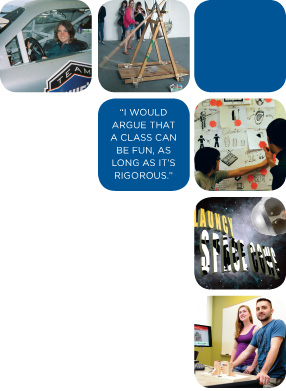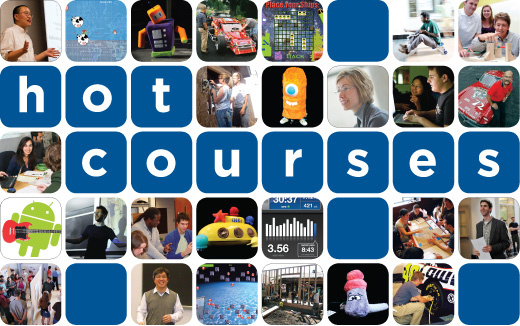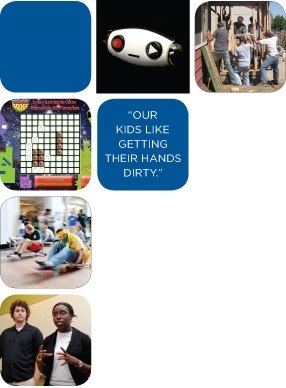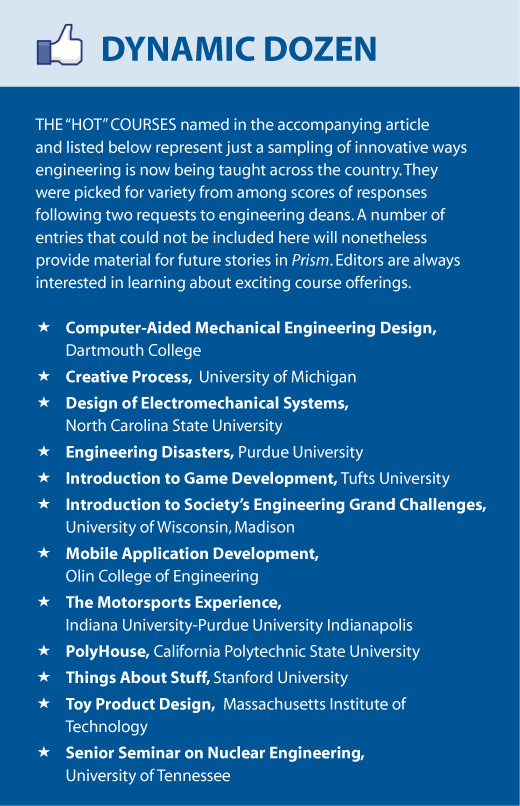Summer 2011 – Feature
+ BY THOMAS K. GROSE
What wows the Facebook generation?
It’s not exactly thermodynamics, but clearly some engineering faculty know how to transfer their energy and wisdom into cool classes that are really and truly . . . hot. You know the ones — courses that are oversubscribed by eager students and sustain their popularity from year to year through word of mouth.
For example, there is Stanford University’s freshman-oriented Things About Stuff. A seminar taught by Tom Lee, a professor of electrical engineering, it helps students understand important scientific principles by covering the history of disruptive technologies and their inventors. Lee limits the class to just 16, and this academic year he had 200 applications. “Winnowing it down was a painful process,” Lee admits, “but it would be difficult to replicate it in a larger setting.” The class is now on hiatus while Lee takes a two-year sabbatical to work for the Defense Advanced Research Projects Agency. But it’s a cinch that it will have freshmen lining up when it resumes in 2013.
What makes courses like Lee’s Things About Stuff so popular? For one thing, they spring from imaginative themes, at times cutting across engineering, the sciences, and humanities. The University of Michigan’s Creative Process class, for instance, is one of many around the country that marry engineering with the arts. But that’s just part of the answer, as ASEE discovered in asking engineering deans across the country to recommend their “hottest,” most innovative and exciting, courses. Many – including a handful described here – are hands-on and project based. Some are timely. Others tap into a passion among today’s students to render the world and their local environment cleaner, safer, more efficient, and equitable. In sum, they may be academe’s ace in the hole for engaging a new generation of skilled and broadly educated engineers.
Getting students to work on teams designing and building things is almost a guaranteed hit. In Lee’s class, one team used signal-processing technology to build a radiation detector from soup cans, while another created a music video for a song team members composed and played. Dartmouth College’s Computer-Aided Mechanical Engineering Design course requires teams to build adult-size “twist cars” and race them. In MIT’s Toy Product Design class, engineering students create and make unique playthings. In PolyHouse, a project management course launched by Roya Javadpour, professor of industrial and manufacturing engineering at California Polytechnic State University, students design and then undertake the renovation of a house belonging to a low-income family with one disabled member.
Smartphone app courses, like Olin College of Engineering’s Mobile Application Development, in which students create apps for Android smartphones, are popping up from coast to coast. “There is a lot of research saying that they [hands-on projects] are an effective teaching method,” says Mark Chang, assistant professor of electrical and computer engineering, who teaches the Olin course. But, he adds, “it’s not just a good pedagogical tool;” it’s a form of teaching that young engineers truly appreciate. “Our kids like getting their hands dirty.”
That’s a sentiment also expressed by Pete Hylton, an associate professor of mechanical engineering technology at Indiana University-Purdue University Indianapolis (IUPUI) who teaches a two-week, intensive summer course called The Motorsports Experience. Project-led courses “are the ones students learn the most from,” he explains. “They capture the interests of students and what they want to be.” Adds Lee: “Once they see how the knowledge [they acquire in theory classes] can be applied, they find it more interesting.” Lee uses the analogy of teaching people to play the violin: “You need to put one in their hands. You can’t lecture them how to play it.”
Learning From Failure
“Book smarts” can take students only so far and won’t give them the skills obtained from working on open-ended projects that have no one right answer, says Gregory Bruckner, the mechanical engineering professor who teaches the Design of Electromechanical Systems graduate course at North Carolina State University. Solomon Diamond, an assistant professor of engineering who teaches the Dartmouth course, agrees. “If you are going to be a mechanical engineer, you’ve got to cut metal.” Potential disaster looms over every project – and that’s a great learning experience. One goal of Michigan’s Creative Process class is to help students realize that failure goes hand in hand with creativity.
At the end of the PolyHouse course, students are required to perform a project audit to determine what worked and what didn’t. “Engineers can learn a lot from mistakes,” says Jose Macedo, head of CalPoly’s industrial and manufacturing engineering department. As Diamond says: “Projects focus the mind on consequences.” Moreover, a well-constructed project unleashes a tsunami of student energy. Diamond’s students put in “crazy” hours. “It’s so competitive, but it is self-motivated,” he says. Student Emily Porter, who took Diamond’s class last year, agrees, saying that she fully enjoyed all the hard work: “Definitely, it’s always more fun when you get to build something. And I really like working in teams.”
The hands-on elements also give students “real world” experiences that translate to marketable skills. For instance, because the PolyHouse students actually undertake a major overhaul of someone’s home, they have to deal with things like limited time, budgets, and poor weather, yet get it done properly and on deadline. That’s very different from learning project management by “overseeing” a fictitious project, Macedo says. “In this case, everything is for real.” Once Chang’s students make their smartphone apps available to consumers, within 90 minutes they are getting feedback from people around the world. “The end goal,” Chang says, “is to put something before the public that can stand on its own.” And students learn that even superb technology doesn’t matter if it’s applied to a bad idea. Ming Chow, the Tufts University lecturer who teaches Introduction to Game Development – a computer science course within the College of Engineering – works hard to give it “a real-world feel.” For instance, it’s a no-textbook course, but it combines nearly all the facets of computer science theory.
Barry Kudrowitz, the mechanical engineer who created the MIT toy class six years ago (and is now planning a version for the University of Minnesota, where he was recently hired as an assistant professor), brings in volunteers from industry to help teach the class and give it an industrial component. Bruckner believes that’s an important element: “I take pride in students telling me they’re learning something practical. It’s industry-relevant, so it is relevant to them.” Of course, sometimes the experts learn a few things, too. Local contractors advise the PolyHouse students, and often they say they’re trying to do too much in too short a time frame. “But the students always pull it off,” Macedo says. “It is incredible.”
Sometimes “hands on” means enlisting students as instructors. In a University of Tennessee nuclear engineering class, graduating seniors research and deliver oral presentations on up-to-the-minute topics, honing communication skills they’ll need in the workplace. This past year, they explored the nuclear near-meltdown in Japan, radiation therapy techniques, nonproliferation, nuclear waste recycling, and small modular reactors, a “hot” issue at the U.S. Department of Energy. Department head Harold L. “Lee” Dobbs approves the topics beforehand and helps students fine-tune their presentations. “The diversity and breadth of topics” that 40 students can present “is more than any one professor can cover in the traditional one-instructor format,” says Dobbs. Invariably, he learns something new.
Tennessee’s course is the kind that gets students to think critically about engineers’ obligation to help protect society. So is a course at Purdue entitled Engineering Disasters. Eric Nauman, associate professor of mechanical engineering, teasingly bills it as a class for those “interested in saving the world, ruling the world,” or who “just want to keep up on current events.” The course is focused on catastrophic design failures — from the Tacoma Narrows Bridge collapse to the recent financial system meltdown — and how they might be predicted and avoided.
The Fun Factor
While many of today’s undergraduates are eager to tackle society’s important problems, Dartmouth’s Diamond keeps in mind that “students are also young people who want to have fun.” No one says learning has to be the pedagogical equivalent of a dental appointment. Kudrowitz’s toy class — understandably — places the frivolity factor front and center. “The play nature is important,” says Kudrowitz, who “treats every class like a show.” Students wear lab coats turned into costumes, and each class begins and ends with music. “It is about toys,” he points out.
Hylton says “it’s obvious” that students in his motorsports class — who get to visit racetracks and meet pit crews — “have a blast, and it’s obvious they learn a lot.” He shies away from using the “f” word because a lot of parents don’t think class time and fun go together. “But,” he adds, “I would argue that a class can be fun, as long as it’s rigorous.” That is Chang’s take as well. “I have high expectations of my students,” he says, acknowledging that creating an app appeals to the smartphone generation. “You can extract more from people if they are having fun; it makes for a much more invigorating experience.” Fun doesn’t mean an easy romp, however. As much as Diamond’s students enjoy making twist cars, they’re typically seniors who have taken at least a dozen tough courses to qualify for his. But the fun is infectious. During the first twist-car race three years ago, Diamond overheard one young woman say, “I am so taking this class.” And eventually, she did.

Sound and Motion
Many hot classes have a cross-disciplinary element. Hylton’s Motorsports Experience mixes his engineering students with business students majoring in motor-sports management at Winston-Salem State University in North Carolina. Chow’s game development course is open to both computer-science majors and nonmajors. Some majors grumble about having nonmajors in the class, he says, but he figures it helps them learn how to deal and communicate with colleagues who are not computer scientists. And that’s truly a real-world experience, since it’s unlikely any of them will ever work just with other programmers once they graduate.
Perhaps the class with the greatest multidisciplinary mix is Michigan’s Creative Process, which is co-taught by engineering, art and design, architecture, dance, and music professors, with a goal of teaching students that “creativity is not a character trait or an event, but a process.” Students not only keep a journal — which can include digital elements, including video — but work on four mini-projects and one large final project that can encompass sound, motion, images, and objects. “This course is labeled by many students as ‘life-changing,’” says David Munson Jr., Michigan’s engineering dean.
Creative Process is also one of several courses that’s not aimed solely at engineering students. Macedo says that students from every one of CalPoly’s colleges have enrolled in the PolyHouse course — including a journalism major. At Stanford, undergraduates don’t declare a major in their freshman year. But only a third of the students who take Lee’s Stuff class are heavily leaning toward science or engineering. In the University of Wisconsin, Madison’s Introduction to Society’s Engineering Grand Challenges course — which helps students understand the benefits of engineering to society — nonengineering students make up anywhere from 20 percent to 30 percent of each year’s class. Susan Hagness, the professor of electrical and computer engineering who created the course, says it’s good that nonengineering students are learning the humanitarian aspects of engineering. In a world that increasingly relies on technology, she says, engineering-oriented tech courses should be part of all liberal arts curricula.
The National Academy of Engineering’s Grand Challenges for the 21st Century have inspired students to think big. Wisconsin’s class looks at topical issues that range from healthcare, to helping the developing world, to alternative energy and the environment. And that is a big draw for engineering students, too. “It resonates with students who want to make a difference in the world,” Hagness says, and a growing percentage of budding engineers fall into that category. Michigan State University takes the Challenges idea a step further: It has created living-learning communities around NAE-cited themes as part of its Cornerstone Engineering Residential Experience program.
They’re Game
Service learning that benefits the greater community has been gaining traction in recent years. Additionally, classes that hit on generational obsessions, like games, also strike a chord with students. Chow admits it’s no surprise that students flock to his game-development course, given the subject matter. “Games are so part of the culture of students now. Everyone plays games.” And most students have smartphones, too. “These students have embraced this technology,” Olin’s Chang says. “That makes it highly motivating.”
Students also gravitate to courses that help them flesh out and apply what they’ve previously learned. Certainly all Stanford freshmen graduated from high school with stellar results. Nevertheless, Lee says, many do not truly understand the answers they’ve learned to parrot to pass tests. “Students are hungry for knowledge,” he says, and that’s a big reason for the popularity of his Stuff class — it sates that need. NCSU’s Bruckner says “something has to give” because of pressures on undergraduate schools to keep mechanical engineering programs to 128 hours while also staying abreast of new technologies. Accordingly, many graduate students don’t fully understand how a motor works, he says, and they see his course as a knowledge fix. Denise Fitzgerald, 39, who works at Lincoln Lab, a federally funded national security R&D center at MIT, can attest to that. She took Bruckner’s course as a distance student nearly 18 years after receiving her bachelor’s degree in mechanical engineering from Worcester Polytechnic Institute, largely because a new job required her to design customized motors, something she had never studied. “It helped me fill in a lot of gaps that were not explained to me as a mechanical engineering student.”
Eric Nauman, the Purdue associate professor of mechanical engineering who teaches Engineering Disasters, thinks he’s helping his students learn new ways of thinking. The course requires them to develop formulas using nonlinear math to help them see how most disasters could have been predicted, and to apply those skills by making a few predictions of their own. They reasoned, for instance, that too many U.S. chemical refineries are “just one bad repair away from something really nasty. They’re certainly looking at the world in a different way.” It’s also an exercise that helps them “connect what they’re learning in different classes,” including thermodynamics and mechanics.
A crucial factor in many hot courses is excellent teaching. They are typically taught by top instructors who are driven to get their students as fired up about a subject as they are. And students relate to that. “I am a gadgets freak,” Chang admits, “so it [smartphone apps] is a topic that’s near and dear to my heart.” Says Dartmouth’s Diamond: “One of my primary objectives is to communicate to students the degree of passion for engineering and design that I have.” Both his twist-car course and Kudrowitz’s toys class rely on previous students returning to mentor current students. “What keeps people coming back is, it’s got to be well-taught,” Kudrowitz explains. And Tufts’ Chow doesn’t hesitate to say: “I bring a lot of high energy to the class.” Foster Lockwood, a Tufts sophomore who took Chow’s game development class as a freshman and wound up inventing an iPhone game app called Facility that’s gotten more than 150,000 downloads, is now designing an iPad game with Chow. “This wouldn’t be possible without Ming,” Lockwood says. “He showed us how to think like a designer.”
It’s also no surprise that Stanford’s Lee gets high marks on student assessments. Wrote one student: “Amazing. Absolutely amazing. I learned so much and had so much fun making things, asking questions, and visiting Prof. Lee at office hours. He knows everything about everything, and is an awesome human being.” Now, that’s hot.
Thomas K. Grose is Prism’s chief correspondent, based in the United Kingdom.
Photos with This Article
TOP IMAGE: First line, from left: Tufts lecturer Ming Chow; Tufts game-development class; MIT toy-design class project; IUPUI’s Motorsports Experience; Tufts game class; Dartmouth “twist-cars” student; NCSU Prof. Gregory Buckner; second line: PolyHouse; toy developed in toy-design class; Wisconsin Prof. Susan Hagness; Tufts game-development class; IUPUI Prof. Pete Hylton; third line: CalPoly Prof. Roya Javadpour; fourth line: Olin’s app class; MIT Prof. Barry Kudrowitz; Michgan Prof. Herbert Winful; toy developed in toy-design class; Tufts game-development class; Prof. Barry Kudrowitz with toy-class students; Dartmouth Prof. Solomon Diamond; fifth line: Wisconsin Grand Challenges presentation; Olin Prof. Mark Chang; Tufts game-development class; PolyHouse; toy developed for toy-design class; motorsports engineering student
SECOND IMAGE: Top to bottom: Wisconsin Grand Challenges presentation; toy developed in toy-design class
THIRD IMAGE: Top to bottom, left to right: Toy from toy-design class; CalPoly PolyHouse; Tufts game-design course; Dartmouth twist-car design students; NCSU students presenting electromechanical designs
FOURTH IMAGE: Top to bottom, left to right: IUPUI motorsports students; Creative Process final project; students brainstorming toy design; Tufts game design; app created in Olin class; NCSU students presenting electromechanical designs; Stanford Prof. Tom Lee (Things About Stuff)
Tufts University Photos by Alonso Nichols for Tufts
Category: Cover Story Features




